Creating a Social Safety Net for Food-Insecure Students
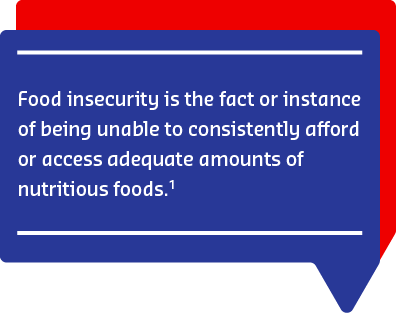 We’ve all heard the jokes about college students’ bleak diets, with stale punch lines about thrifty staples like instant ramen, dry cereal, a medley of soup cans and other microwave-ready meals. The trope of the hungry college student has become so culturally ubiquitous that this period of strife is sometimes depicted as a sort of rite of passage — a routine trial to endure on the path to “real” adulthood.
We’ve all heard the jokes about college students’ bleak diets, with stale punch lines about thrifty staples like instant ramen, dry cereal, a medley of soup cans and other microwave-ready meals. The trope of the hungry college student has become so culturally ubiquitous that this period of strife is sometimes depicted as a sort of rite of passage — a routine trial to endure on the path to “real” adulthood.
While the gravity of the problem is often masked by vague humor and platitudes, the truth is, hunger on campus is a far more serious issue than many of us realize.
Food insecurity is the fact or instance of being unable to consistently afford or access adequate amounts of nutritious foods.[1]
32% — nearly one third — of today’s college students are food insecure.[2]
 Recent data compiled on student hunger indicates that for a growing number of students, food insecurity is a very real and daily struggle — a struggle that, at best, hinders their academic success and at worst, facilitates their decision to drop out of school entirely.
Recent data compiled on student hunger indicates that for a growing number of students, food insecurity is a very real and daily struggle — a struggle that, at best, hinders their academic success and at worst, facilitates their decision to drop out of school entirely.
34% of students say they know someone who has dropped out of college due to difficulties affording food.[1]
Many of these students resort to drastic measures to combat food insecurity, such as increasing debt, skipping meals, working second jobs and — what is perhaps the grimmest of strategies on this list — taking “poverty naps” to stave off hunger pangs.
At Sodexo, people are at the heart of what we do. And as the world’s leading provider of food services, we recognize that we have a crucial role to play in leading the fight to end hunger.
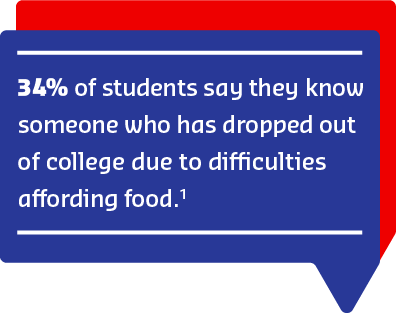 That’s why, by partnering our efforts with those of our clients, as well as established hunger relief organizations, we’ve worked toward assembling a social safety net for food-insecure students on campus — a set of initiatives and tangible actions designed to drive meaningful improvements in the lives of those we serve, on campus and off.
That’s why, by partnering our efforts with those of our clients, as well as established hunger relief organizations, we’ve worked toward assembling a social safety net for food-insecure students on campus — a set of initiatives and tangible actions designed to drive meaningful improvements in the lives of those we serve, on campus and off.
To achieve food security on campuses, we’ve identified four objectives that both include and extend beyond immediate food aid to comprehensively break the cycles and root causes of hunger:
- Creating economic access to nutritious foods
- Increasing physical access to no-cost basic needs
- Helping students build skills and sustainable income
- Facilitating strategic coordination in the fight to end hunger
We realize it takes a united front to develop effective, scalable solutions to hunger, so we have banded together with campus partners and other strategic hunger-relief organizations in our efforts to meet these objectives.
We collaborate with our clients to assess the varying, specific needs of each campus, as well as the innovative supports already in place to relieve those needs. By tapping into the wealth of established resources and networks at universities nationwide, Sodexo works to expand and enhance the impact of campus-led anti-hunger activities and strategies.
Below, we share how some of the various partnerships, initiatives, programs and resources we’ve been aiding and implementing align with our hunger-relief objectives.
1. Creating economic access to nutritious foods
Swipe Out Hunger (SOH)
To reduce food insecurity on college campuses, Sodexo partnered with Swipe Out Hunger — a leading nonprofit organization dedicated to preventing student hunger — to launch a first-of-its-kind pilot program of Meal Swipe Banks at 12 participating universities across the U.S. during spring of 2020.
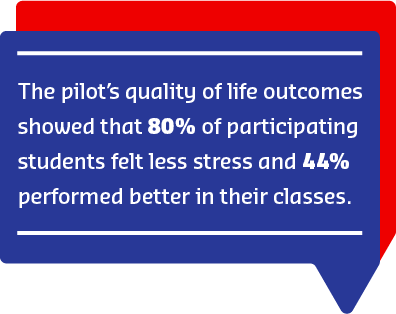 By donating one free meal swipe each semester per mandatory meal plan sold, Sodexo is able to establish “banks” of meal swipes for food-insecure students to readily access. The donated swipes are then distributed directly onto student ID cards in blocks of 5-15. The program is designed to offer students a stigma-free solution to food insecurity on campuses. While the social and cultural stigmas attached to resources such as food pantries might inhibit students from accessing food-based needs, the Swipe Out Hunger program allows students to swipe for meals at dining halls alongside their friends, without having to self-identify as food insecure.
By donating one free meal swipe each semester per mandatory meal plan sold, Sodexo is able to establish “banks” of meal swipes for food-insecure students to readily access. The donated swipes are then distributed directly onto student ID cards in blocks of 5-15. The program is designed to offer students a stigma-free solution to food insecurity on campuses. While the social and cultural stigmas attached to resources such as food pantries might inhibit students from accessing food-based needs, the Swipe Out Hunger program allows students to swipe for meals at dining halls alongside their friends, without having to self-identify as food insecure.
The Meal Swipe Bank program banked 15,520 meals in the spring pilot semester, with 7,035 meals distributed to 1,115 students. The total number of redeemed meals for the pilot semester stands at 4,236.
The pilot program’s quality of life outcomes showed that 80% of participating students felt less stress and 44% performed better in their classes.
 Since the pilot, the Meal Swipe Bank program has been implemented at 27 Sodexo-partnered university campuses — about a quarter of our ultimate 100-campus goal. Although the main priority of the program is to alleviate students’ emergency food needs through meal redemptions, its goals also include reduced food waste and increased academic performance.
Since the pilot, the Meal Swipe Bank program has been implemented at 27 Sodexo-partnered university campuses — about a quarter of our ultimate 100-campus goal. Although the main priority of the program is to alleviate students’ emergency food needs through meal redemptions, its goals also include reduced food waste and increased academic performance.
A warm, nourishing meal can make a significant difference in the life of a college student, whether physically, mentally, financially or academically. Partners like Sodexo understand how critical it is to ensure every student has access to food. Working together, we can reach even more students and ensure they have the opportunity to thrive as they earn their degree. —Rachel Sumekh, Founder and CEO of Swipe Out Hunger
To get involved or learn more about SOH’s impact, visit Swipe Out Hunger.
Supplemental Nutrition Assistance Program (SNAP) Benefits
The Supplemental Nutrition Assistance Program (SNAP) is a federal aid program that supplements the food budget of individuals impacted by poverty and hunger. SNAP recipients are able to use their benefits to purchase food items at participating stores.
Partnering with campuses, Sodexo works to determine the need and feasibility of aligning campus convenience store stock to meet SNAP vendor eligibility requirements for food insecure students. Our teams have experience in navigating the United States Department of Agriculture (USDA) process for the SNAP vendor application and have successfully implemented the program at Loyola Marymount University’s C-Lions.
2. Increasing physical access to no-cost basic needs
Food Recovery Network (FRN)
In 2013, the Sodexo Foundation invested in Food Recovery Network (FRN) to help the grassroots program transition into a nationwide nonprofit organization. Today, the organization is the largest student-led movement fighting to reduce waste and hunger in America. Since its inception at University of Maryland, College Park, FRN has been working to glean surplus foods from campus dining halls, food vendors, restaurants and farms across the United States.
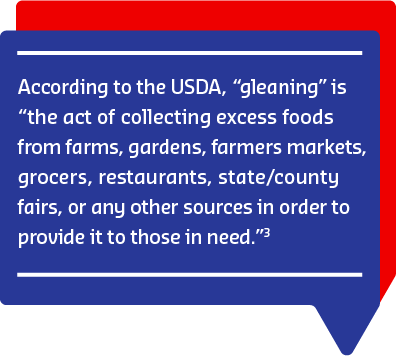 According to the USDA, “gleaning” is the act of collecting excess foods from farms, gardens, farmers markets, grocers, restaurants, state/county fairs or any other sources in order to provide it to those in need.
According to the USDA, “gleaning” is the act of collecting excess foods from farms, gardens, farmers markets, grocers, restaurants, state/county fairs or any other sources in order to provide it to those in need.
Sodexo is one of the largest donors of surplus perishable and nonperishable food in the world. FRN unites students on college campuses to fight food waste and hunger by recovering perishable food from Sodexo-run operations (athletics, catering, residential dining) that would otherwise go to waste. During the 2020-2021 academic year, 43 active FRN student chapters located on Sodexo-operated campuses recovered 47,136 pounds of food, equivalent to 39,238 meals, with the help of 860 volunteers.
Interested in learning more about youth-led innovations underway in the FRN movement?
Visit Food Recovery Network.
Campus food pantries
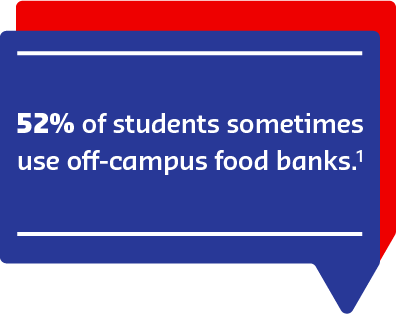 52% of students sometimes use off-campus food banks.[1]
52% of students sometimes use off-campus food banks.[1]
Campus pantries are crucial emergency resources for food-insecure college students. The Sodexo Stop Hunger Foundation has made it a priority to alleviate the food-insecurity crisis by providing grant-based funding for on-campus, nonprofit food pantries. In 2021, the foundation saw a threefold increase in the number of requests for food pantry grants. To meet this need, Stop Hunger awarded 89 campus food pantry grants in November of 2021.
During 2020, the Stop Hunger foundation partnered with 27 campus food pantries that logged over 2,800 volunteer hours. The Stop Hunger grant contributed to providing the equivalent of 108,000 meals.
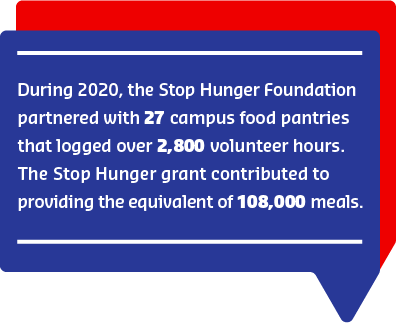 Beyond securing funding for pantry operations, Sodexo is committed to working in partnership with clients to coordinate supportive programs for campus pantries, including food drives, C-store "Donate to the pantry" promotions, food recovery partnerships, and purchasing of equipment and bulk products, such as laundry detergent.
Beyond securing funding for pantry operations, Sodexo is committed to working in partnership with clients to coordinate supportive programs for campus pantries, including food drives, C-store "Donate to the pantry" promotions, food recovery partnerships, and purchasing of equipment and bulk products, such as laundry detergent.
Community gardens
On-campus community gardens increase the availability of nutritious foods on campus, educate the student population about healthy, fresh ingredients and sustainable food systems, and strengthen community ties on campus. At some campus gardens, a percentage of the annual yield is donated to food pantries, local charities or other resources for food-insecure students. During the 2020 garden season, gardeners at the Idaho State University (ISU) community garden donated 3,592 pounds of produce and more than 800 hours of service for those in need.
Sodexo’s Stop Hunger Foundation supports campus clients interested in implementing community gardens by helping to facilitate partnerships with local nonprofit organizations.
Surplus catering food distribution networks
At select campuses, Sodexo has partnered with clients to build a surplus food catering alert program that notifies food-insecure students of the availability of surplus food after a catered event. To properly adhere to food safety standards, the excess catering food is available only for a discrete amount of time post-event and is to be consumed on-site at the event space.
There are several technology solutions models we use to facilitate this program in partnership with campuses. For example, Northern Arizona University uses its campus app to alert students of surplus food through its Louie’s Leftovers program. Lehigh University simply uses the GroupMe app for surplus catering alerts.
3. Helping students build skills and sustainable income
Student employment
Sodexo liaisons with clients to offer students a variety of on-campus employment opportunities within dining and catering service roles.
Our student employment opportunities prioritize flexible scheduling to ensure that students are able to focus, first and foremost, on their academics. While these employment opportunities act as valuable, sustainable sources of income for food-insecure students, they also equip undergraduates with career-related skills to help them prepare for their futures beyond college.
Student leadership opportunities
Student Manager Program
Sodexo’s Student Manager Program is designed to give student employees of Sodexo a chance to move into managerial and supervisory roles. The program provides students with valuable leadership experience and the potential for a future career with Sodexo. Student managers are introduced to a vast array of responsibilities, including supervising, hiring and training part-time student employees, controlling student labor costs, and ensuring compliance with account operating standards and procedures.
Stop Hunger youth leadership initiatives
One of Stop Hunger Foundation’s priorities is developing youth leadership that will one day impact the systemic issues contributing to hunger. That’s why the foundation funds and partners with student-led nonprofits like Swipe Out Hunger (SOH), Congressional Hunger Center, Share Our Strength, Youth Service America and Food Recovery Network (FRN) — organizations that have youth leadership initiatives built into their programs to empower students to meaningfully address the root causes of hunger.
Each year, Stop Hunger also recognizes 5 youth scholars through its Stephen J. Brady Scholarship program. These young people are awarded for developing innovative solutions to end hunger in America.
Student internships
Sodexo offers 120 internships each year to help students gain work experience, build career-related skills and explore potential career paths. Our campus internships range from fields such as marketing to dietetics, with concentrations in topics including graphic design, sustainability and health and wellness.
UCOOK cooking classes
College is where most young adults first learn to fend for themselves. Many university students have no prior experience managing their own nutritional needs and budgets. Facilitating students’ food education — teaching them about proper nutrition and meal preparation — is one substantial way to increase food security on campus.
To help enrich students’ food education, Sodexo introduced UCOOK stations in select campus dining halls — sites where diners are able to prepare their own meals while being overseen and guided by professional culinarians. Students are provided a variety of ingredients and equipment while chefs demo how to cook on a budget or make a fresh meal from local produce. Easy-access, on-campus sites like UCOOK, where students can learn to cook for themselves, makes skills-building a fun, hands-on experience.
4. Facilitating strategic coordination in the fight to end hunger
Stop Hunger Foundation
Since 1996, the Sodexo Stop Hunger Foundation has been acting sustainably and locally for a hunger-free world and quality of life for all. The foundation’s coordination efforts secure food aid and safety nets for food-insecure university students through grants that fund food pantries and large nonprofit organizations operating within college settings, like SOH, FRN and the Congressional Hunger Center.
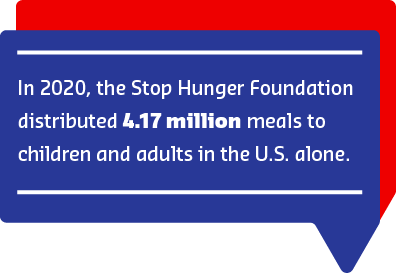 While Stop Hunger aims to provide immediate relief to food-insecure people, the foundation’s vision also stretches beyond food aid to address the root causes of hunger. Effectively eliminating hunger means developing solutions to the systemic issues that create the conditions for hunger. That’s why much of the foundation’s grant-based funding goes toward workforce and youth leadership development programs, gardening initiatives and other skill-development initiatives. With an eye to the future, the organization also strategically invests in advocacy initiatives that work to educate, empower and engage people in the fight to end hunger.
While Stop Hunger aims to provide immediate relief to food-insecure people, the foundation’s vision also stretches beyond food aid to address the root causes of hunger. Effectively eliminating hunger means developing solutions to the systemic issues that create the conditions for hunger. That’s why much of the foundation’s grant-based funding goes toward workforce and youth leadership development programs, gardening initiatives and other skill-development initiatives. With an eye to the future, the organization also strategically invests in advocacy initiatives that work to educate, empower and engage people in the fight to end hunger.
In 2020, the Stop Hunger Foundation distributed 4.17 million meals to children and adults in the U.S. alone.
Get involved in our fight for a hunger-free world at Stop Hunger.
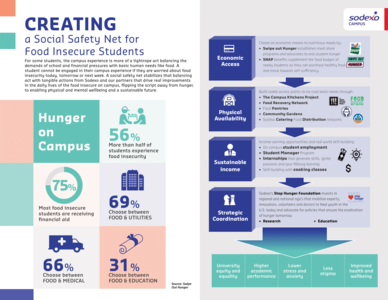 Download our Social Safety Net for Food-Insecure Students Infographic
Download our Social Safety Net for Food-Insecure Students Infographic